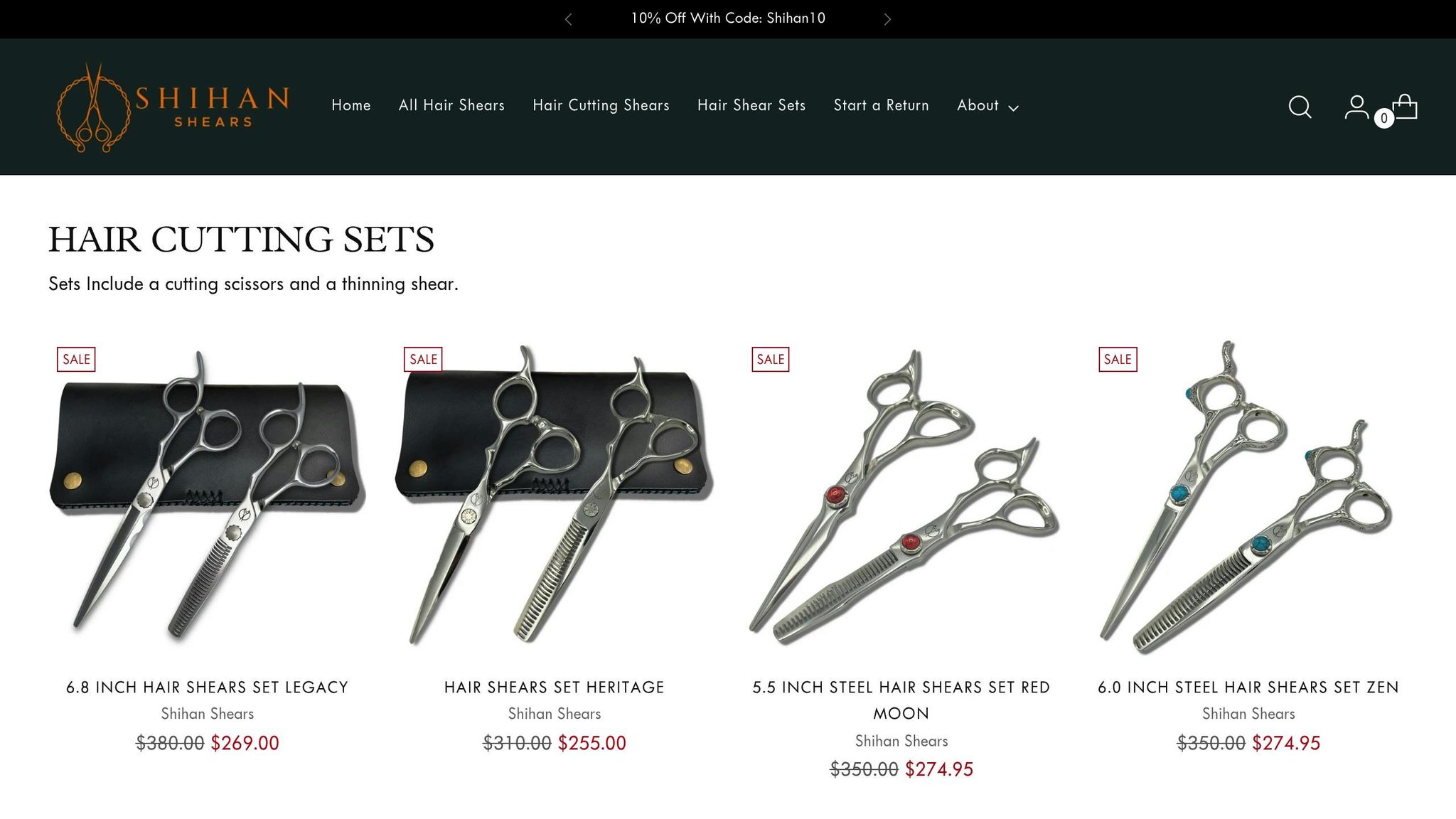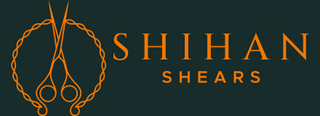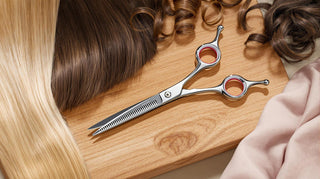Choosing the right shears can transform your cutting experience. The right tools improve precision, reduce hand strain, and enhance your results. Here’s what you need to know:
- Blade Types: Convex edges are sharp and precise, ideal for advanced techniques. Beveled edges are durable and great for basic cuts.
- Length: Shorter shears (4.5"-5.5") suit detail work, while longer ones (6.5"+) are better for bulk removal.
- Handles: Ergonomic designs like offset and crane handles reduce strain during extended use.
- Materials: Japanese steel offers durability and sharpness, with premium grades like ATS-314 excelling in performance.
- Hair Type Match: Use shorter blades for fine hair and longer ones for thick hair. Thinning and texturizing shears help in blending and creating texture.
- Maintenance: Clean, lubricate, and sharpen your shears regularly to maintain performance and longevity.
Quick Comparison of Blade Edges
| Feature | Convex Edge | Beveled Edge |
|---|---|---|
| Sharpness | Extremely sharp, precise cuts | Sharp but needs more pressure |
| Durability | Fragile, requires care | Sturdy, longer-lasting |
| Cost | Higher-priced | Budget-friendly |
Investing in high-quality shears tailored to your cutting style and maintaining them properly ensures better results and a more comfortable experience.
A Buyers Guide to Choosing the Right Hairdressing Scissors
Blade Types and Uses
Knowing the right blade type can make all the difference when it comes to precise cuts and staying comfortable during long styling sessions. Let’s break down the key blade designs and their uses.
Convex vs. Beveled Edge Comparison
Choosing between convex and beveled edges can greatly affect your cutting experience. Here’s a quick comparison:
| Feature | Convex Edge | Beveled Edge |
|---|---|---|
| Sharpness | Extremely sharp; perfect for advanced techniques like slide cutting, point cutting, and texturizing | Sharp but needs more pressure, making it ideal for blunt cuts or scissor-over-comb methods |
| Durability | Fragile; requires careful handling | Sturdier and more long-lasting |
| Cost | Generally higher-priced | More budget-friendly |
"A convex edge is the sharpest, finest edge you can get on any shear and is best used for finishing work." - Kenchii Grooming
Convex edges are your go-to for advanced techniques, while beveled edges work better for basic cutting methods. But blade profiles - whether straight or curved - also play a big role in accuracy and control.
Straight and Curved Blade Options
Straight blades are all about precision. They’re great for:
- Creating clean, straight lines
- Even pressure in basic layering
- Tight, detailed trimming
On the other hand, curved blades offer added flexibility, especially for beginners. They help with:
- Better control and reduced hair slippage
- Adjusting for natural hand movements
- Easier maneuvering around curved areas of the head
Think about the cutting styles you use most often when picking a blade. The right choice can boost both your efficiency and the quality of your work.
Choosing the Right Shear Length
The length of your shears directly impacts your cutting precision. Let’s break down how to choose the right size for your needs and techniques.
Standard Lengths and Their Best Uses
Shears generally range from 4.5 to 8 inches, measured from the blade tip to the end of the longest handle. Here’s how different lengths are typically used:
| Shear Length | Best Applications | Key Benefits |
|---|---|---|
| 4.5" - 5.5" | Precision work, pixie cuts, detailed texturing | Greater control and easy handling in tight areas |
| 5.75" - 6.25" | General cutting, layering, palm-to-palm cutting | Balanced design for versatile use |
| 6.5 inches and longer | Scissor-over-comb, slide cutting, bulk removal | Covers more area with smoother, longer strokes |
"The length of the hair shear should be driven more by the cutting techniques you use." - Sensei Shears
How to Find Your Best Fit
While hand size isn’t the main factor in choosing shear length, comfort and control are essential to avoid fatigue during long sessions. Here’s how to find the right fit:
-
Test the Balance
Hold the shears with the tip of the blade aligned with the tip of your middle finger. This ensures better control and reduces hand strain. -
Consider Your Cutting Style
If you specialize in detailed work, shorter shears (5.5 inches or less) provide more precision. For blunt or bulk cuts, longer shears (6.5 inches or more) allow for efficient strokes. -
Match to Techniques
- Precision styling: 4.5"–5.5"
- General cutting: 5.75"–6.25"
- Bulk removal: 6.5 inches and up
Testing shears with your usual cutting motions can help you decide. A 6-inch pair is often a great all-around option to start with.
Next, we’ll look at how handle designs can improve your overall cutting experience.
Handle Designs for Better Comfort
Pick handle designs that provide comfort throughout the day and help reduce strain. Many modern shears are designed with ergonomics in mind to help prevent injuries.
Handle Types Compared
Different handle designs suit various cutting styles and comfort needs. Here's a breakdown of the main types:
| Handle Type | Best For | Benefits for Comfort | Ideal Cutting Techniques |
|---|---|---|---|
| Classic/Opposing | Traditional cutting methods | Offers basic control and familiarity | Deep point cutting and basic cuts |
| Offset | Long cutting sessions | Eases thumb strain with natural hand positioning | Texturizing and precision work |
| Crane | Stylists with wrist concerns | Promotes a lower elbow position and reduces shoulder strain | Detailed work with less stress |
| Swivel | Dynamic, versatile techniques | Provides flexibility and reduces repetitive strain | Texturizing and layering |
For extended cutting sessions, aim for a handle diameter of 1.6 inches (41 mm) and a grip length of roughly 5.5 inches (140 mm). Tools that limit wrist flexion, extension, and deviation can help prevent repetitive strain injuries.
Up next, learn how to position your fingers to enhance these ergonomic advantages.
Correct Finger Position Guide
Proper finger placement is key to maintaining control and reducing strain. Here's how to position your fingers based on the handle type:
-
Classic/Opposing Handle
Place your middle finger in the bottom ring and your thumb in the top ring. Keep your wrist straight. This setup works well for traditional cutting techniques. -
Offset Handle
Position your ring finger in the larger bottom ring and your thumb in the smaller top ring. Keep your wrist in a natural position. This setup is ideal for longer cutting sessions. -
Crane Handle
Use a similar finger placement as the offset handle. Let your elbow drop naturally and keep your shoulders relaxed. This is especially helpful for those dealing with or trying to avoid carpal tunnel syndrome.
For better grip and control, opt for textured handles rather than smooth surfaces. This reduces the pressure needed to maintain control.
sbb-itb-a50b05d
Materials and Build Quality
The materials used in shears directly influence their performance, durability, and comfort during use. Japanese steel is widely regarded for its sharpness and strength. Let’s dive into the details of different Japanese steel grades.
Japanese Steel Types Explained
The grade of Japanese steel determines key factors like blade sharpness, edge retention, and resistance to rust. These qualities are often measured by the Rockwell Hardness Rating (HRC).
| HRC Rating | Quality Level | Price Range | Characteristics |
|---|---|---|---|
| 50-55 HRC | Basic | $50–199 | Suitable for beginners, less durable |
| 57-59 HRC | Mid-range | $149–400 | Sturdy, resists rust, good for regular use |
| 60-62 HRC | Premium | $299–1,000 | Professional-grade, holds edge well |
| 61-63 HRC | Ultra-premium | $700–1,500 | Exceptional quality, top-tier performance |
High-end steels like ATS-314 and VG-10 are enhanced with cobalt and titanium, offering superior strength and precision. For instance, the Legacy Hair Shears Set by Shihan Shears uses ATS-314 steel, ensuring top-notch edge retention and performance tailored for professionals.
Special Coatings and Features
In addition to the steel itself, advanced coatings can enhance both the performance and lifespan of shears. Here are two standout types:
-
Titanium-based Coatings: These coatings can boost cutting efficiency by 2 to 5 times compared to uncoated tools.
- Hardness: 4000HV
- Heat resistance: Up to 1,832°F
- Excellent wear resistance
- Reliable under frequent use
- DLC (Diamond-Like Carbon): Known for its smoothness, this coating offers high wear resistance and prevents material from sticking to the blade, making it ideal for precise cutting tasks.
Japanese-made shears are crafted with precision and held to strict quality standards. Although premium Japanese shears come with a higher upfront cost ($300–$1,500), their long-lasting durability often makes them a more cost-effective choice over time.
Shears for Different Hair Types
Selecting the right shears for hair texture can elevate your cutting technique. Beyond blade types and handle design, tailoring your tools to the hair type ensures precision and efficiency.
Cutting vs. Texturizing Tools
The right blade can make all the difference when cutting. Here's how blade length and features align with different hair textures:
| Hair Type | Recommended Blade Features | Best For |
|---|---|---|
| Fine/Thin | Shorter blades (5–5.75") | Detailed work, precision cuts |
| Medium | Standard blades (6") | Versatile cutting techniques |
| Thick/Coarse | Longer blades (6.5–7") | Removing bulk efficiently |
Thinning and Texturizing Shears
Thinning and texturizing shears help achieve specific texturing effects. Thinning shears, with 20–40 closely spaced teeth, are ideal for blending layers and removing weight subtly. On the other hand, texturizing shears, featuring 5–14 widely spaced teeth, create noticeable texture and movement.
"Perfect for condensed cutting techniques or texturizing thick, coarse dry hair" – Sam Villa Team
Keep these tips in mind:
- Use wide-tooth thinning shears to manage thick hair and add texture effectively.
- Avoid thinning hair too close to the roots to preserve volume.
- Use texturizing shears sparingly on fine hair to prevent over-thinning.
Here's a quick comparison of thinning and texturizing shears:
| Characteristic | Thinning Shears | Texturizing Shears |
|---|---|---|
| Teeth Count | 20–40 teeth | 5–14 teeth |
| Spacing | Close together | Wide spacing |
| Primary Use | Weight reduction | Creating texture |
| Best Results | Subtle blending | Noticeable movement |
| Hair Types | All types, especially thick | Medium to thick |
For thick hair, shears crafted from 16-layer Damascus steel offer durability and exceptional edge retention.
Up next, we’ll cover how to properly care for your shears to maintain their performance.
Shear Care and Maintenance
Taking care of your shears not only keeps them cutting smoothly but also helps them last longer. A little effort each day and a consistent maintenance routine can protect your investment and keep your tools in top shape.
Daily Care Steps
Clean your shears after every client to avoid buildup and maintain sharpness. Use a soft chamois cloth, wiping away from the cutting edge to prevent accidental cuts. For a deeper clean, follow these steps:
| Step | Process | Frequency |
|---|---|---|
| Basic Cleaning | Use warm soapy water and sanitize | After each client |
| Deep Cleaning | Apply an alcohol-based solution to remove buildup | End of day |
| Lubrication | Use professional shear oil | Weekly |
| Tension Check | Adjust the pivot screw | Daily or Weekly |
Always ensure your shears are thoroughly dried before storing them to avoid rust.
Professional Maintenance Schedule
A regular maintenance schedule ensures your shears stay sharp and function properly over time. Here’s a suggested routine:
- Weekly: Lubricate with a premium dry wax-based lubricant (about $22.00) and adjust tension using a scissors key.
- Monthly: Perform a deep cleaning and inspect for any wear or damage.
For sharpening, follow these guidelines:
- High-quality shears: Sharpen professionally every 6–12 months.
- Standard shears: Sharpen every 3–5 months.
During each sharpening session, request a complete blade inspection to catch any issues early.
Consider investing in a Shear Care Kit (around $22.50), which typically includes essentials like oil, rings, a chamois cloth, and a scissors key.
When not in use, always store your shears in a protective case. Many premium options, like those included with Shihan Shears' sets, feature leather cases designed to guard against damage and keep blades aligned. Proper storage ensures your shears are ready to perform at their best when you need them.
Conclusion
The right shears can improve your technique, make your work more efficient, and keep you comfortable during long styling sessions.
Key Points to Remember
Choosing the right shears is all about precision and reducing fatigue. Here's a quick breakdown of factors to consider:
| Factor | Impact | What to Look For |
|---|---|---|
| Blade Type | Affects precision | Convex blades for smooth cuts; beveled blades for detailed work |
| Length | Influences control | Match the length to your hand size and cutting style |
| Handle Design | Impacts comfort | Pick a handle that suits your grip and workload |
| Material Quality | Determines performance | Japanese steel offers durability and sharpness |
While professional-grade Japanese steel shears may require a higher initial investment, their durability and performance make them worth it in the long run.
Shihan Shears Options

Here are some top choices from Shihan Shears to help you apply these principles:
- Legacy Hair Shears Set ($269.00): Includes a 6.8-inch cutting shear and a 6-inch thinning shear for flexibility.
- Red Moon Hair Shears Set ($274.95): Combines a 5.5-inch cutting shear with a 6-inch thinning shear for precision work.
- Zen Model ($174.95): A budget-friendly option for those entering the professional-grade market.
All Shihan Shears come with a lifetime warranty, giving you peace of mind about your investment.
Select shears that align with your cutting style, hand size, and professional needs. With proper maintenance, high-quality shears will be a reliable tool in your styling journey for years to come.

